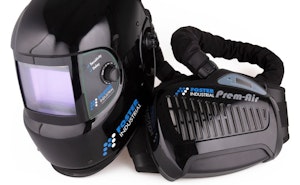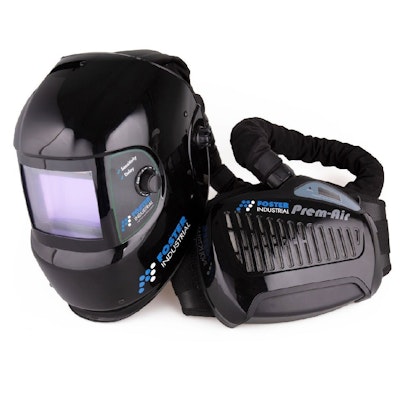MIG Welding Safety
The potential for electric shock when welding
Our Advice
The welding machine is connected to the mains supply. On a weekly basis, check the security and electrical integrity of the cables. Check the cable insulation is not showing any signs of wear, discoloration or signs of overheating and that there are no splits or cracks. Only attempt to repair any damage if you are qualified to do so. If you are not, employ the services of an electrician.
Electric welding, including MIG, operates on the basis of a series circuit. There are two leads involved, a welding lead and the welding return lead. The welding lead connects to the positive terminal of the machine and carries the welding current from the machine (away). The second lead, the welding return lead is clamped to the work bench or on to the work piece as close as possible to the welded joint.
The leads must be checked every day before use to ensure there is no damage to the insulation along their length and that the connection to the terminals of the machine are secure. Pay particular attention to the connection of the return lead to the clamp. There are often signs of the copper cable fraying, as it connects to the return clamp. Fraying reduces the current carrying capacity of the welding cable. Both leads must be rated electrically the same as the maximum output of the welding machine. This means that if your machine is rated at 315 amps, the leads must be able to carry out and return 315 amps safely.. Should the leads catch fire they can melt and also cause irreparable damage to the machine.
Radiation burns from welding
Electric welding involves extremes of light and heat. This light effect when combined with the heat generated when welding (6500˚C) is harmful and can lead to radiation burns to the eyes, face, neck, arms and hand. It looks like a dose of sun burn & could increase the chance of skin cancers in later life.
Personal protective equipment (PPE) is essential in protecting the operator from radiation burns.
You require the following PPE:
-Flame retardant overalls
-Safety boots/shoes
-Leather gauntlets (not gloves). Gauntlets offer protection up to the elbow.
-An air fed Welding helmet


Safety Advice
Welders Dance
This is the movements generated by the welder when feeling the intense burning sensation caused by hot molten metal going down the neck, sleeves or into footwear. The burns are very painful and partial thickness burns and will leave scarring.
Never look directly at the welding arc with your bare eyes, a moments neglect can lead to possibly the most uncomfortable 12 to 36 hour period of your life. We refer here to a condition known in the industry as “arc eye”.
Exposing the eye to the welding arc can lead to a burning of the eyeball and an inflammation of the cornea. The condition develops over a 3 to 4 hour period and starts with an itching of the eye.
There is no real treatment for arc eye. Eye drops with some local anesthetic can be prescribed and applied and give some relief for a short period in every four hour period. The effects are not permanent and last anywhere between 12 and 36 hours. Your eyes will be sore and tired. You will be incapable of welding and should refrain from doing so for a minimum of 24 hours after the effects have worn off.
Having ensured your own safety, don’t forgot to protect other operatives from the effects of the welding arc. Erect Welding Curtains & Screens around your work area, post warning notices and tell anyone close to you that you are about to strike your arc.
The effects of heat and burns
To safeguard yourself, wear fire resistant overalls and the leather protective equipment. Check the seams on your gauntlets are intact; the smallest particle of hot molten metal at a temperature in excess of 1400˚C will find its way through the smallest of holes in any seam and burn you.
Burns can be superficial; red and sore with no swelling or blistering, swollen, blistering with removal of layers of skin or burnt through skin, fat and muscle layers to reveal bones. Do not remove any burnt clothing from a burn site and after cooling, cover the injury with a sterile dressing.
With the high temperatures involved in welding that there is a risk of dehydration. Ensure that you drink plenty of water to keep yourself hydrated and that natural ventilation is made the most of.


Fire caused by welding sparks
What to do:
Your work area can be alight in a second if you’re not careful and do not pay attention to detail in the preparation of your working area. We know that the sparks given off by the welding process are extremely hot and are the perfect source of ignition for any solid fuel fire. Before welding remove any paper, wood, rags, paints and solvents from your work area.
Ensure that you have the appropriate fire extinguisher at hand and that you know how to correctly discharge this equipment in an emergency. If you can have someone as a second pair of eyes to look for early signs of fire, particularly if you are working on a vehicle, in a production area or in a confined space. This person is known as a fire watch. Fire watch should be maintained for a period of up to 1 hour after the welding activity has finished.
Suitable fire extinguishers are Carbon Dioxide or Dry Powder because of the risk of electrical fires in the welding area. Do NOT use a water based extinguisher on an electrical fire.
Welding flammable containers or vessels
Try to avoid this as there is a real chance of some form of explosion occurring. Vapour has a much lower flashpoint than the liquid and will explode with much greater energy. If you decide that you are going to undertake this repair you must ensure that any residual vapor has been removed by prolonged high pressure steam cleaning (the longer the better). Needless to say the water vapor left by the steam cleaning process requires time to dry. This type of repair can be expensive to undertake because of the cleaning and drying time involved and the cost of this must be considered against the benefits of buying a new vessel. In this instance “penny pinching” could seriously injure you and others around you.
You may not need to steam clean; the objective here is to nullify the explosive environment of the enclosure. An alternative is to fill the vessel with an inert gas such as Argon or Nitrogen and displace the explosive gases.


Welding Fume
Take caution :
Welding uses high temperatures to essentially melt metal at a point local to the heat source. This creates a cloud of harmful smoke that can contains particles of filler wire, parent material, weld metal, oils, paints or grease and the shielding gas being used.This fume is unpleasant and where possible should not be breathed in.
There are lots of actions you can take to protect yourself as a welder. Be aware of your breathing zone, this is the area 12” up from the joint area and 12” from the front of your welding helmet.
Your objective is to minimise the amount of fume cloud passing through or hanging about in this area. If you use a fume extractor system position the extractor fan nozzle at the back of your breathing zone to draw the fume cloud away from you. An extractor nozzle or hood positioned above your head is completely ineffective and just draws the fume cloud past your breathing zone quicker. The objective is to get the fume cloud away from your breathing zone and not through it quickly.
We suggest to purchase an air fed welding helmet, such as the Foster Prem-Air. Buy a W3 compliant weld fume eliminator with on torch extraction, such as the Foster Works X300A. As mentioned earlier, choose PPE & welding fume extraction based upon your budget and your welding environment. All the equipment recommended above will offer a level of protection for you in your own right and become more effective when used in combination.
Safety Summary
- Be aware of the hazards involved.
- Check your welding equipment and work area before starting welding.
- Understand your equipment and how it works.
- Ensure you have Respiratory Personal Equipment(RPE) & Local Exhaust Ventilation(LEV) in place.
- Look after your co-workers by purchasing fume extraction & screening off the job.
Shop Mig Welding
Shop Featured Equipment
More lessons in this series
01509 509269






















